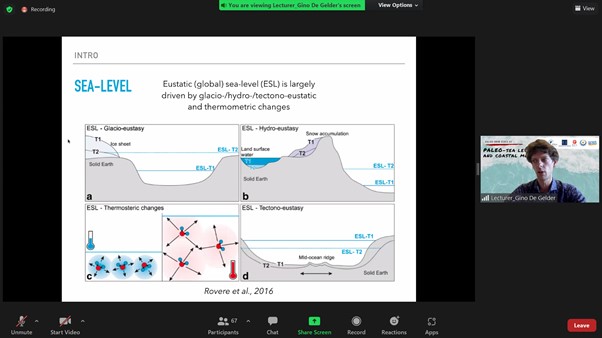The Importance of Sea-Level Measurement in Estimating Global Volume of Ice Sheets
By Adi Permana
Editor Adi Permana

BANDUNG, itb.ac.id — Gino de Gelder,a professor and researcher from ISTerre, Université Grenoble Alpes, France- stated that the changes in sea level elevation can be triggered by climate change, shifts in the water cycle, and tectonic movements.
"This change dates back to the Holocene period when most of the polar ice had melted due to volcanic activities and tectonic shifts. These phenomena cause the sea level to rise 130 meters higher than the previous period," Gino stated during his lecture on Friday (10/29/2021).
The transition is observed from the change in the ratio of stable isotopes (18O to 16O) found in fossil shells of certain organisms. "In this case, we are using fossilized foraminifera. The isotope ratio content in this shell can determine the age of marine sediments and create a reconstruction of sea-level inconstancies," he explained.
In his presentation, Gino discussed the importance of measuring sea-level elevation to estimate the global volume of ice sheets. The measurement is also helpful in estimating the spatial and temporal responses to climate change; the results can bring more context in understanding local tectonic activities and estimating the dangers of earthquakes. Moreover, sea-level measurement is the key to recording paleogeographic traces and predicting human migration models. Thus, forecasts of sea levels are crucial to anticipate the future negative influences on the environment.
Relative fluxes in sea levels are monitored with several indicators. Sea terraces--destructional lands that are formed due to tides that decline sea levels--are one of those indicators. Others include mangroves and tidal swamps in intertidal zones.
Gino showed some of his marine terrace modelings from various regions. These models are constructed differently; some are created due to erosion (wave-cut terraces), sedimentation of material carried by waves (wave-built terraces), or coral reefs.
“Terrace formation is influenced by its initial slope, removal rate, initial rate of erosion, and its history of recorded sea levels," Gino added.
Gino emphasized that changes in sea levels are not solely impacted by man. Many human activities that produce carbon emissions cause global climate change that raises sea levels. Furthermore, the increasing human population results in more buildings being made and a decline in land level. Nature, however, also contributed to this change. For instance, tectonic and geodynamic processes on Earth cause the rise and fall of sea level.
“Efforts that can be done to overcome the adverse effects of sea-level changes are mangrove planting and coral reef preservation. Both can also prevent erosion," he concluded.
Collaboration Event
ITB Oceanography Study Program participated in the NUSANTARA program held by the Basic Partnership Research Scheme 2021. This program collaborated with Université de Nantes, ISTerre, BRIN (Badan Riset dan Inovasi Nasional) Indonesia, the Ministry of Marine Affairs and Fisheries of Indonesia, and the Kampus Merdeka program organized by the Ministry of Education.
The event was attended by ITB students majoring in Oceanography as well as students from other study programs. The topics conveyed in this lecture covered information regarding Paleo-Sea Level and Coastal Modeling.
The public lecture was opened by the Dean of Faculty of Earth Sciences and Technology, Dr. Irwan Meilano, S.T., M.Sc. On the other hand, the moderator of this event was Dr.rer.nat. Rima Rachmayani, S.Si., M.Si. (professor from the ITB Oceanography Program).
Reporter: Maharani Rachmawati Purnomo (Oseanografi, 2020)
Translator: Ruth Nathania (Teknik Lingkungan, 2019)

.jpg)
.jpg)
.png)
.jpg)
.jpg)

